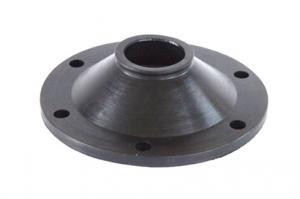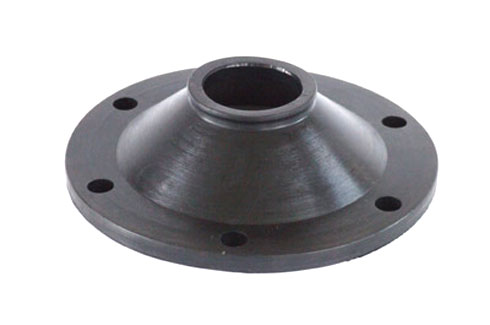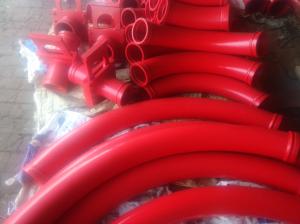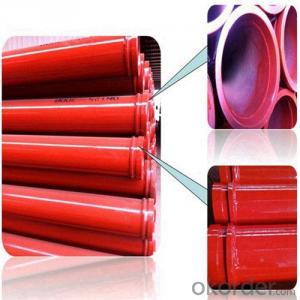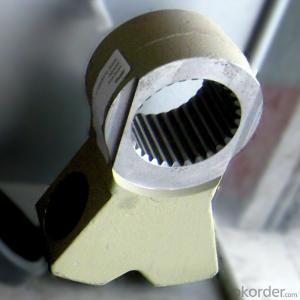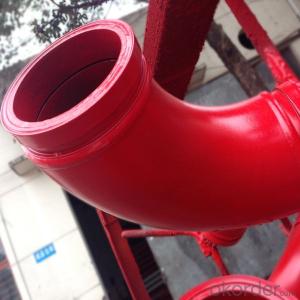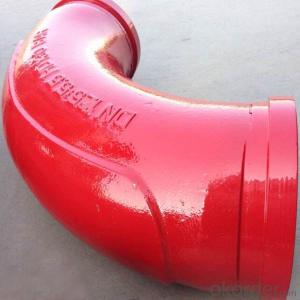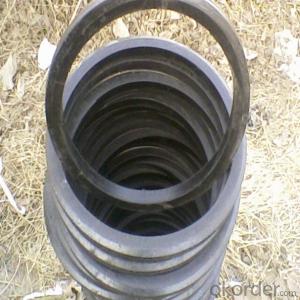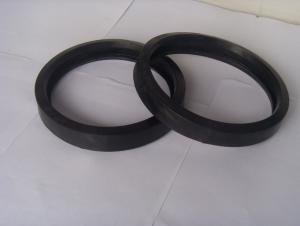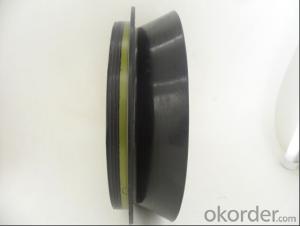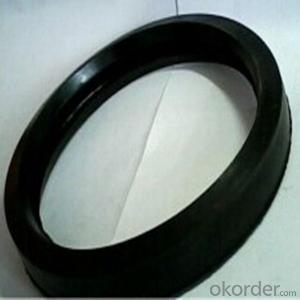Tapering Seal DN125 & DN150
- Loading Port:
- China Main Port
- Payment Terms:
- TT OR LC
- Min Order Qty:
- -
- Supply Capability:
- -
OKorder Service Pledge
OKorder Financial Service
You Might Also Like
Including: 1) Wear-resisting Board andCutting ink for Schwing, Putzmeister, Sany, Zoomlion, Kyokuto
2) Seal Ring/ Gasket for Schwing, Putzmeister, Sany
3) Schwing Kidney 10029138
4) Pipe Clean-out Accessories: Sponge ball, Sponge Column, Cleaningpiston
5) Conveying Cylinder for Schwing, Putzmeister
Products:
1) Rubber hose
2) Putzmeister/ Schwing/ Zoomlion/ SermacRam Pistons
3) Putzmeister/ IHI/ Kyokuto/ Zoomlion/Sany Seperated Piston
4) Wear-resisting board and Cuts ink
5) Coupling and seal ring for Putzmeister,Schwing, Sany
6) ST52 steel pipe, elbow, reducer
7) Cleaning seriesand others- Q: Are there any specific guidelines for the selection and installation of hydraulic components in concrete pump spare parts?
- Concrete pump spare parts have specific guidelines for the selection and installation of hydraulic components. When choosing these components, it is important to consider factors like the maximum operating pressure, flow rate, and compatibility with the existing hydraulic system. First and foremost, it is crucial to ensure that the selected hydraulic components can handle the maximum operating pressure of the concrete pump. This includes components such as hydraulic cylinders, valves, and pumps. To ensure their durability and longevity, it is advisable to choose components with a higher pressure rating than that of the concrete pump's operating pressure. Additionally, the flow rate of the hydraulic components must match the requirements of the concrete pump system. Hydraulic pumps and valves need to provide sufficient flow to effectively operate the concrete pump. Factors such as the size of the concrete pump, desired output capacity, and specific pumping requirements should be taken into consideration. Furthermore, compatibility with the existing hydraulic system is vital for the smooth operation of the concrete pump. It is important to select hydraulic components that are compatible with the system in terms of fittings, connections, and overall design. Seeking guidance from the manufacturer's guidelines or professional advice is recommended when selecting and installing hydraulic components in concrete pump spare parts. Moreover, proper installation is essential to ensure optimal performance and safety of the hydraulic components. Following the manufacturer's installation instructions and guidelines is highly recommended. The installation process should include proper alignment, secure mounting, and appropriate sealing of the components to prevent any leaks or failures. In conclusion, there are specific guidelines for selecting and installing hydraulic components in concrete pump spare parts. Considering factors like maximum operating pressure, flow rate, compatibility, and following proper installation procedures can help ensure the efficient and safe operation of the concrete pump system.
- Q: What is the purpose of a concrete pump electric motor?
- The purpose of a concrete pump electric motor is to provide the necessary power and torque to pump concrete from one location to another, eliminating the need for manual labor and increasing efficiency in construction projects.
- Q: How often should concrete pump outriggers be inspected and maintained?
- Concrete pump outriggers should be inspected and maintained regularly, ideally before each use and at least once a month. This ensures their proper functioning and helps prevent any potential accidents or damage.
- Q: What are the performance characteristics of concrete pump?
- A long stroke cylinder extends the service life of the cylinder and the piston
- Q: How can a malfunctioning hydraulic motor affect the pumping process?
- A malfunctioning hydraulic motor can have various negative effects on the pumping process. Firstly, it can result in a decrease in pumping efficiency. The hydraulic motor is responsible for converting the hydraulic energy into mechanical energy, which drives the pumping mechanism. If the motor is malfunctioning, it may not be able to generate enough power to operate the pumping system effectively, leading to a decrease in the volume or pressure of the pumped fluid. Additionally, a malfunctioning hydraulic motor can cause an increase in energy consumption. Inefficient or faulty motor operation can lead to higher energy requirements to maintain the desired pumping rate. This increased energy consumption can result in higher operating costs and reduced overall system performance. Furthermore, a malfunctioning hydraulic motor can lead to irregular pumping or complete pump failure. If the motor is not functioning properly, it may result in intermittent or inconsistent pumping, causing fluctuations in the flow rate or pressure of the pumped fluid. In extreme cases, the motor may completely stop working, leading to a total loss of pumping functionality. Moreover, a malfunctioning hydraulic motor can cause increased wear and tear on the entire pumping system. The motor's improper operation can create excessive vibration or heat, leading to premature failure of other components such as seals, bearings, or pistons. This can result in frequent maintenance or repair requirements, leading to increased downtime and costs. In summary, a malfunctioning hydraulic motor can have significant negative impacts on the pumping process, including decreased efficiency, increased energy consumption, irregular pumping or complete pump failure, and increased wear and tear on the system. It is crucial to regularly inspect and maintain hydraulic motors to ensure their proper functioning and avoid potential issues that may disrupt the pumping process.
- Q: How long do concrete pump rubber hoses typically last?
- The lifespan of concrete pump rubber hoses may vary based on several factors. Typically, these hoses last between 5 to 10 years on average. However, factors such as hose quality, frequency and intensity of use, concrete type, and maintenance can impact this estimate. To prolong the lifespan of concrete pump rubber hoses, regular inspection and maintenance are crucial. It is important to check for signs of wear and tear, like cracks, abrasions, or bulges, and address any issues promptly. Additionally, proper storage and handling are essential to prevent unnecessary damage. Avoiding excessive bending, kinking, or dragging of the hose can greatly extend its durability. It should be noted that certain conditions, such as exposure to extreme temperatures, abrasive materials, or chemicals, can accelerate wear and reduce the hose's lifespan. Therefore, considering these factors is vital when determining the expected longevity of a concrete pump rubber hose. Ultimately, while concrete pump rubber hoses generally last 5 to 10 years, their durability and lifespan can be influenced by various factors. By practicing proper maintenance, care, and considering operating conditions, the life of the hose can be significantly extended, ensuring safe and efficient use.
- Q: Can I use alternative materials for concrete pump spare parts?
- Yes, alternative materials can be used for concrete pump spare parts. However, it is important to ensure that these materials meet the required specifications and standards for durability, strength, and compatibility with the concrete pumping system. Additionally, it is advisable to consult with professionals or manufacturers to ensure the safe and efficient functioning of the equipment.
- Q: What are the elements of concrete pump and concrete pump truck selection?
- The performance of the random type varies depending on the type and structure of concrete pump truck building, in addition to considering the choice of models into the concrete pouring amount, should also consider the building type and structure, technical requirements, construction site conditions and environment etc.. The main performance parameters of the concrete pump vehicle should be in line with the construction requirements or slightly larger. If the capacity is too large, the utilization rate is low, too small, not only can not meet the requirements, but also will accelerate the loss of the concrete pump truck.
- Q: Are there any warranties or guarantees on concrete pump spare parts?
- Yes, there are warranties and guarantees offered on concrete pump spare parts. Many manufacturers and suppliers provide warranties on their products to ensure the quality and performance of the spare parts. These warranties may vary in duration and coverage depending on the specific supplier or manufacturer. It is important to check with the supplier or manufacturer to understand the terms and conditions of the warranty or guarantee before purchasing the concrete pump spare parts. Additionally, some suppliers may also offer extended warranties or guarantees for an additional cost, providing further peace of mind to the customers.
- Q: How to choose concrete pump?
- A concrete delivery pump has the following main technical parameters: conveying displacement, outlet pressure, motor power and distribution valve form.
Send your message to us
Tapering Seal DN125 & DN150
- Loading Port:
- China Main Port
- Payment Terms:
- TT OR LC
- Min Order Qty:
- -
- Supply Capability:
- -
OKorder Service Pledge
OKorder Financial Service
Similar products
Hot products
Hot Searches
Related keywords
